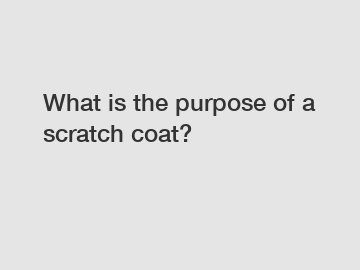What is the purpose of a scratch coat?
If you are planning to undertake a new construction project that involves applying stucco or other types of mortar to a surface, you may have come across the term "scratch coat." But what exactly is a scratch coat, and what purpose does it serve in the construction process? In this blog post, we will delve into the world of scratch coats and explore their importance in ensuring a successful and long-lasting finish for your project.
A scratch coat, also known as a key coat or bonding coat, is a thin layer of mortar that is applied to a substrate before the final coat of stucco or plaster is added. The purpose of the scratch coat is to provide a rough, textured surface that helps the subsequent coats of mortar adhere securely to the substrate. By creating a strong bond between the scratch coat and the surface, the overall integrity and durability of the finish are greatly enhanced.
So why is it important to use a scratch coat in construction projects? One of the main reasons is that it helps to prevent the final coat of stucco or plaster from cracking or delaminating over time. Without a properly prepared surface to bond to, the finish coat may not adhere correctly, leading to issues such as water infiltration, mold growth, and structural damage. By applying a scratch coat, you are creating a solid foundation for the rest of the layers to adhere to, ensuring a long-lasting and visually appealing finish.

Another key benefit of using a scratch coat is that it helps to level out any inconsistencies in the substrate, such as uneven surfaces or gaps in the underlying material. By applying a thin layer of mortar that can be manipulated and shaped to match the contours of the surface, you are able to create a smooth and uniform base for the final finish coat. This not only improves the overall aesthetic of the project but also helps to maintain the structural integrity of the surface over time.
In addition to providing a strong bond and a level surface, a scratch coat also helps to regulate the absorption of moisture in the substrate. By creating a barrier between the finish coat and the surface, the scratch coat can help to prevent excess moisture from seeping into the substrate and causing damage. This is particularly important in areas with high humidity or exposure to the elements, where moisture infiltration can lead to a host of problems such as mold growth, efflorescence, and deterioration of the finish.
So how is a scratch coat applied in a construction project? The process typically involves preparing the substrate by cleaning and priming the surface to ensure good adhesion. Once the surface is ready, the mortar mix is applied in a thin, even layer using a trowel or other suitable tool. The mortar is then scored or roughened with a scratcher or other implement to create the desired texture and provide a key for the finish coat to adhere to. After allowing the scratch coat to cure for a specified period of time, the final coat of stucco or plaster can be applied to complete the project.
In conclusion, the purpose of a scratch coat in construction projects is to provide a strong bond, a level surface, and moisture regulation for the subsequent layers of mortar or stucco. By taking the time to properly prepare the substrate and apply a scratch coat, you can ensure the success and longevity of your project. Whether you are working on a new build or renovating an existing structure, incorporating a scratch coat into your construction process is a crucial step in achieving a durable and aesthetically pleasing finish.
Want more information on types of coil coatings, coating aluminum coil china manufacture, pvdf coating on steel? Feel free to contact us.

Comments
0